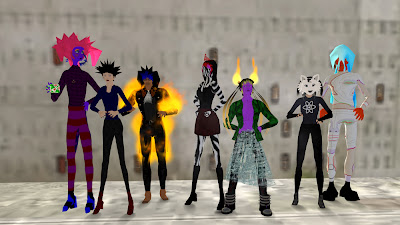
+Commissioned by Rhizome.org+
A LEAP INTO THE VOID: INTERVIEW WITH SECOND FRONT
by Domenico Quaranta
At first sight they may appear like a pop hybrid between the X-men and the Four Horsemen of the Apocalypse, reviewed through the exaggerated and postmodern aesthetics of a virtual world such as Second Life. Quite the contrary. They are the first performance art group in Second Life: serious guys, practicing artists, curators and academics in real life, who decided to sound out the performative possibilities offered by a public virtual space that is growing at an impressive rate and being filled up by media agencies, stores, products, brands and inhabitants.
Second Front (http://slfront.blogspot.com/) officially formed on November 23, 2006, gaining new members up right until the last few days. Now they are: Wirxli Flimflam aka Jeremy Owen Turner; Tea Chenille aka Tanya Skuce; Man Michinaga aka Patrick Lichty; Alise Iborg aka Penny Leong Browne; Tran Spire aka Doug Jarvis; Great Escape aka Scott Kildall; Lizsolo Mathilde aka Liz Pickard; Gazira Babeli aka CLASSIFIED.
The attention of “in world” media comes fast, even if Second Front doesn't seem to work much on communication: its very first performances are set up, unannounced, in public spaces, for a little, unconscious audience. Then, almost immediately (January 5, 2007) comes the big intervention scored at Ars Virtua Gallery – the most notable contemporary art gallery in Second Life – for the opening of the visionary installation by the American artist John Craig Freeman (JC Fremont in Second Life). And may other performances...
Saying that Second Front is opening new paths in an unexplored territory is not rhetorical; and the loose, immodest and a little bit punkish way in which they do it is definitely unrhetorical. Their key feature is openness: openness and plurality of visions and perspectives, quite blatant in this interview (where almost each one of them decided to give his/her answer to the same question); they are open about a wide range of interventions, from reenactment to improvisation to code performing; open about different ways of shaping their work for the art audience, from prints to video to live broadcasting. They are growing up before our very eyes. And, rest assured, they hold good things in store.

